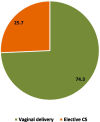Mode of delivery preferences: the role of childbirth fear among nulliparous women
- PMID: 38034315
- PMCID: PMC10687373
- DOI: 10.3389/fpsyg.2023.1221133
Mode of delivery preferences: the role of childbirth fear among nulliparous women
Abstract
Introduction: The increasing Cesarean Section (CS) rates may be attributed to women's increasing requests for elective CS. High Fear of Childbirth (FOC), especially among nulliparous women, may be significantly associated with CS preference without medical indications. The current study aims to investigate the impact of childbirth fear on the mode of delivery preference among nulliparous women.
Methods: A cross-sectional correlational study was performed in the Maternal and Children Hospital (MCH) from the beginning of October 2022 to the end of February 2023 and incorporated a convenience sample of 342 nulliparous women. The data was collected using a self-reported questionnaire comprising participants' demographic and obstetrics characteristics and the FOC questionnaire. A logistic regression model examined the relationship between CS preference and the other independent variables.
Results: The results indicated that 74.3% of the nulliparous women preferred vaginal delivery, while 25.7% preferred Cesarean Section. Concerning childbirth-related fear, the highest mean scores were related to fear of clinical procedures, fear of harming or distressing the infant, and fear of pain 5.19 ± 1.13, 5.12 ± 1.27, and 5.09 ± 1.22, respectively. High FOC was present among 74.6%, moderate in 17.3%, and severe in 6.7% of the participants. Logistic regression analysis showed maternal age and monthly income were the significant sociodemographic determinants of choosing CS as the preferred delivery mode (p < 0.05). Moreover, the participants who had increased fear of harming or distressing the infant, fear from pain, fear from the body's ability to give birth, fear from not being involved in decision-making, and overall FOC had a higher probability of choosing CS as the preferred delivery mode compared to the participants who had lower fear (p < 0.05).
Discussion: Having high FOC increases the CS preference among nulliparous women. Increased fear of harming or distressing the infant, fear from pain, fear from the body's ability to give birth, and fear from not being involved in decision- making seem to be significant dimensions of childbirth fear associated with CS preference among nulliparous women.
Keywords: Cesarean Section; Saudi Arabia; childbirth fear; mode of delivery; nulliparous.
Copyright © 2023 Elgzar, Alshahrani and Ibrahim.
Conflict of interest statement
The authors declare that the research was conducted in the absence of any commercial or financial relationships that could be construed as a potential conflict of interest.
Figures
Similar articles
-
Determinants of Prenatal Childbirth Fear during the Third Trimester among Low-Risk Expectant Mothers: A Cross-Sectional Study.Healthcare (Basel). 2023 Dec 25;12(1):50. doi: 10.3390/healthcare12010050. Healthcare (Basel). 2023. PMID: 38200956 Free PMC article.
-
Obstetric outcomes for nulliparous women who received routine individualized treatment for severe fear of childbirth - a retrospective case control study.BMC Pregnancy Childbirth. 2014 Apr 3;14:126. doi: 10.1186/1471-2393-14-126. BMC Pregnancy Childbirth. 2014. PMID: 24694283 Free PMC article.
-
Fear of childbirth in nulliparous and multiparous women: a population-based analysis of all singleton births in Finland in 1997-2010.BJOG. 2014 Jul;121(8):965-70. doi: 10.1111/1471-0528.12599. Epub 2014 Feb 4. BJOG. 2014. PMID: 24494605
-
Interventions for fear of childbirth including tocophobia.Cochrane Database Syst Rev. 2021 Jul 7;7(7):CD013321. doi: 10.1002/14651858.CD013321.pub2. Cochrane Database Syst Rev. 2021. PMID: 34231203 Free PMC article.
-
Women's views of birth after cesarean section.J Obstet Gynaecol Res. 2021 Dec;47(12):4270-4279. doi: 10.1111/jog.15056. Epub 2021 Oct 5. J Obstet Gynaecol Res. 2021. PMID: 34611958 Review.
Cited by
-
Determinants of Prenatal Childbirth Fear during the Third Trimester among Low-Risk Expectant Mothers: A Cross-Sectional Study.Healthcare (Basel). 2023 Dec 25;12(1):50. doi: 10.3390/healthcare12010050. Healthcare (Basel). 2023. PMID: 38200956 Free PMC article.
-
Effect of acupoint hot compress on relieving pain in primiparous women during the latent phase of the first stage of labour: a study protocol for a prospective, multicentre, randomised controlled clinical trial.BMJ Open. 2025 May 22;15(5):e094226. doi: 10.1136/bmjopen-2024-094226. BMJ Open. 2025. PMID: 40404328 Free PMC article.
-
Effect of antenatal education on pregnant women`s knowledge, attitude and preferences of delivery mode.BMC Pregnancy Childbirth. 2024 Nov 12;24(1):740. doi: 10.1186/s12884-024-06922-0. BMC Pregnancy Childbirth. 2024. PMID: 39533248 Free PMC article. Clinical Trial.
-
Prevalence and factors associated with fear of childbirth in late pregnancy: a cross-sectional study.Front Public Health. 2025 May 30;13:1589568. doi: 10.3389/fpubh.2025.1589568. eCollection 2025. Front Public Health. 2025. PMID: 40520265 Free PMC article.
References
-
- Alabdullah H. A., Ismael L., Alshehri L. A., Alqahtani S., Alomari M., Alammar A., et al. . (2021). The prevalence of C-section delivery and its associated factors among Saudi women attending different clinics of King Khalid University Hospital. Cureus. 13:e12774. doi: 10.7759/cureus.12774, PMID: - DOI - PMC - PubMed
-
- Aljabri W. A., Al-Jifree H. M., Saleh O. (2021). Factors that impact favoring cesarean section among women in Saudi Arabia. Int J Med Dev Countr. 5, 1324–1331. doi: 10.24911/IJMDC.51-1620821442 - DOI
-
- Alkhazal B. A., Halawani M. A., Alsahabi I. O., Abduljabbar H. S. (2021). The preferred mode of delivery among primigravida middle eastern women. A questionnaire based study. Clin. Exp. Obstet. Gynecol. 48, 567–571. doi: 10.31083/j.ceog.2021.03.2384 - DOI
LinkOut - more resources
Full Text Sources
Medical




